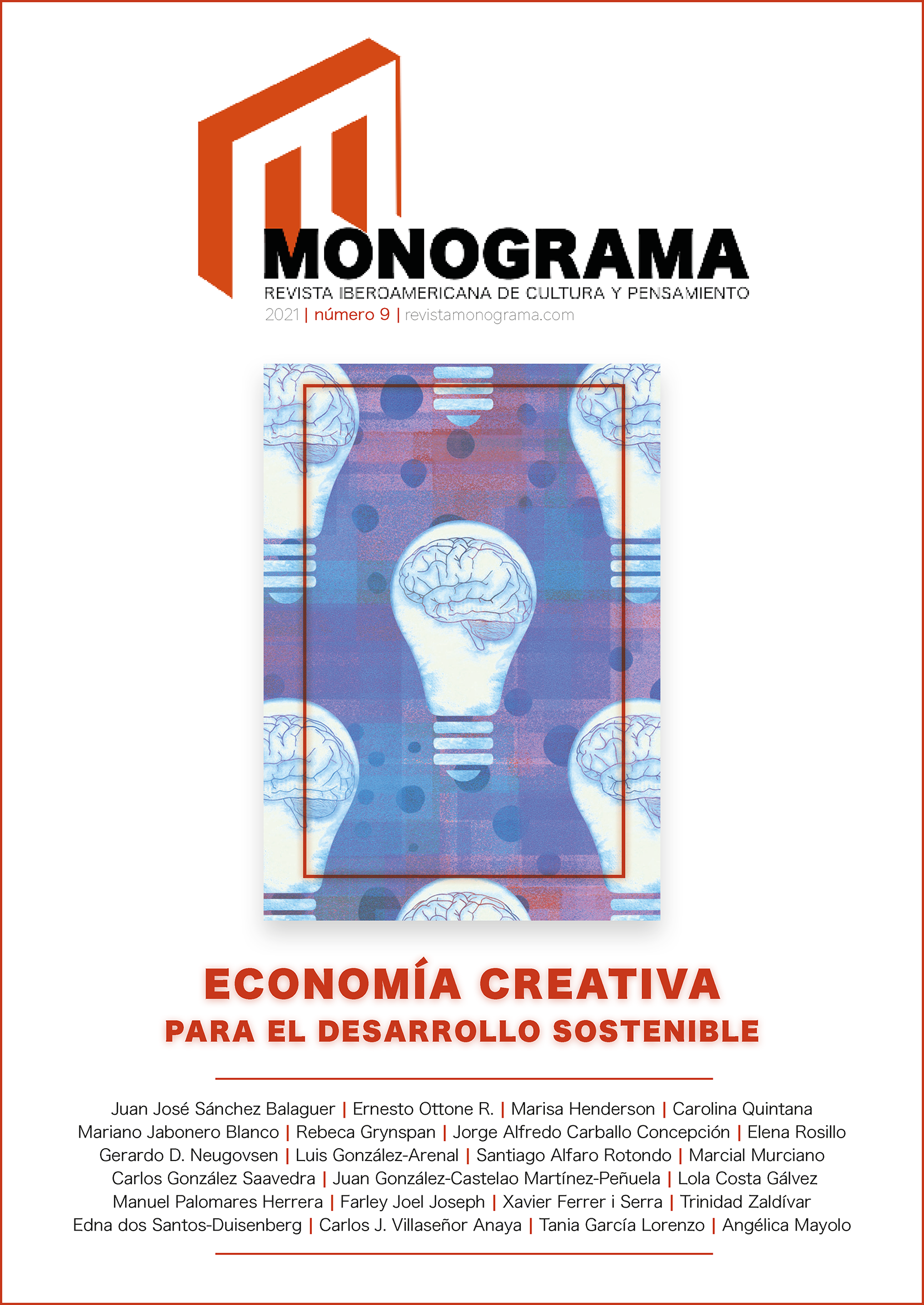From Value Chain to Complex Adaptive Systems in Creative and Cultural Industries
DOI:
https://doi.org/10.36008/monograma.2021.09.2039Keywords:
creative and cultural industries, entrepreneurship, complexity theory, network theory, complex adaptative systems, microeconomicsAbstract
The main characteristics of the Creative and Cultural Industries are analysed as a complex adaptive system. Its behaviour can be explained following the Network Theory, in contrast to the commonly used concept of productive chain or value chain. The focus of the paper is on the question: what is the dynamic relationship between the creative and cultural industries and the rest of the economy? It is understood that the creative and cultural industries are made up of a complex network of individuals and organizations, characterized by a direct or indirect connection with cultural and creative activity, but in turn these same actors are dynamically linked with others industries, which are not necessarily creative or cultural. But those interactions are essential for their effective operation, even when many of those actors are not usually included when the creative and cultural sector is analysed. Multiple interactions are created in several levels forming a complex network, which will be analysed in this text. As a result of this analysis, it is possible to map and further understand the dynamic relationships that are established between the multiple and various intervening stakeholders.
Downloads
References
Anheier, H. e Isar, Y. R. (2008). Cultures and globalization: the cultural economy. Londres: SAGE.
Barbera, F. (2006). «A Star is Born? The Authors, Principles and Objectives of Analytical Sociology». Papers. Revista de Sociología (en inglés), 80, pp. 31‑50.
Barnes J. A. (1954). «Class and Committee in a Norwegian Island Parish». Humans Relations, 7.
Bille H. T. (1995), «Measuring the Value of Culture». Revista Europea de Política Cultural, vol. 1, n.º 2, pp. 309‑322.
Bowman, C. y Ambrosini, V. (2000). «Value creation versus value capture: Towards a a coherent definition of value in strategy». British Journal of Management, 11, pp. 1‑15.
Buitrago, F, (2013). La economía naranja, una oportunidad infinita. Washington D. C.: Banco Interamericano de Desarrollo.
Castronova, E. (2006). Synthetic Worlds: The Business and Culture of Online Games. Chicago: University of Chicago Press.
Chan, S. (2001). Complex Adaptive Systems. ESD.83 Research Seminar in Engineering Systems. Disponible en: http://web.mit.edu/esd.83/www/notebook/Complex%20Adaptive%20Systems.pdf.
Cunningham, S. (2007). A new economics for creative industries and development. WIPO, International conference on intellectual property and the creative industries.
Design Council (UK) (2004). «The Impact of Design on Stock Market Performance: An Analysis of UK Quoted Companies 1994‑2003».
Design Taskforce (2003). «Success by Design NZ: A Report and Strategic Plan», Design Raskforce in Partnership with New Zealand Government, in support of the Growth and Innovation Framework (GIF).
Devesa, M., Báez, A., Figueroa, V. y Herrero, L. (2012). «Repercusiones económicas y sociales de los festivales cuturales: el caso del Festival Internacional de Cine de Valdivia». IEURE, vol. 38, n.º 115. Disponible en: http://www.scielo.cl/pdf/eure/v38n115/art05.pdf.
Diment, K., Yu, P. y Garrety, K. (2012). «Complex Adaptive Systems as a Model for Evaluating Organisational: Change Caused by the Introduction of Health Information System». Health InformatICCs Research Lab, Faculty of InformatICCs, University of Wollongong, School of Management.
Goss, D. (2005). «Schumpeter’s Legacy? Interaction and Emotions in the Sociology of Entrepreneurship». Entrepreneurship Theory and Practice, 29(2), pp. 205‑219.
Hagoort, G. (2007). «Cultural Entrepreneurship. On the freedom to create art and the freedom of enterprise», conferencia inaugural, University of Utrecht.
HKU (2010).The Entrepreneurial Dimension of the Cultural and Creative Industries. Utrecht: Hogeschool voor de Kunsten Utrecht.
Howard, D. y Crompton J. (2004). Financing Sport (2.ª ed.). West Virginia: Tecnología de Información sobre Fitness: Morgantown.
Howkins, J. (2001). The creative Economy. How People Make Money from Ideas. Londres: Penguin Books Limited.
Klamer, A. (1996). The Value of Culture, On the relationship between economICCs and arts. Ámsterdam: Amsterdam University Press.
Kloudova, J. y Chwaszcz, O. (2014). «The analysis of the creative industry linked in connection with the economic development». E & M Ekonomie a Management, 17(1), pp. 32‑42.
Menger, C. (2007). El método de las ciencias sociales. Madrid: Unión Editorial.
Ministero de Cultura (2009). Manual de emprendimiento cultural. Bogotá: Ministerio de Cultura.
Neugovsen, G. (2017). Creación de valor en las Industrias Culturales y Creativas. Buenos Aires: ESEADE.
Nicolas, Y. (2010). «El impacto económico de una actividad cultural como motivo de apoyo público: definición y condiciones de validez». Disponible en: http://www.cairn.info/revue‑d‑economie‑politique‑2010‑1‑page‑87.htm.
Ordóñez, D. (2006). La singularidad de los bienes creativos: aterrizando las diferencias, en Arte y parte: manual del emprendimiento en artes e industrias creativas. Bogotá: Ministerio de Cultura, Cámara de Comercio de Bogotá y British Council.
Phister, P. W. (2010). «Cyberspace: The Ultimate Complex Adaptive System». The International C2 Journal, vol. 4, n.º 2.
Potts, J. y Cunningham, S. (2007). «Four Models of the Creative Industries», CCI working paper, QUT.
Requena Santos, F. (2003). Análisis de redes sociales: orígenes, teorías y aplicaciones. Madrid: Alianza Editorial.
Schumpeter, J. A. (1934). The Theory of Economic Development. Cambridge, MA: Harvard University Press.
Seaman, B. (1987). «Estudios de impacto artístico: un exceso de moda». En: Radich, A. J. y Schwoch S. Impacto económico de las artes. Washington, D. C.: Conferencia Nacional de Legislaturas Estatales, pp. 43‑75.
Stam, E., De Jong, J. y Marlet, G. (2008). Creative Industries in the Netherlands: Structure, Development, Innovativeness and Effects on Urban Growth. Geografiska Annaler: Series B.
Tullin, P. (2012). «Why cultural entrepreneurship is a win‑win scenario for the sector». Disponible en: https://www.theguardian.com/culture-professionals-network/culture-professionals-blog/2012/sep/24/cultural-entrepreneurship-technology-remix-ebook?goback=.gde_4726013_member_260900739.
Von Mises, L. (1949). Human Action: A Treatise on EconomICCs. New Haven: Yale University Press.
Wellman, B. (1988). «El análisis estructural de las redes sociales: del método y la metáfora a la teoría y la sustancia». Social Structures: A Network Approach. Cambridge University Press.
Downloads
Published
How to Cite
Issue
Section
License
Copyright (c) 2021 Monograma. Revista Iberoamericana de Cultura y Pensamiento

This work is licensed under a Creative Commons Attribution-NonCommercial-NoDerivatives 4.0 International License.
Esta obra está bajo una licencia de Creative Commons Reconocimiento-NoComercial-SinObraDerivada 4.0 Internacional






